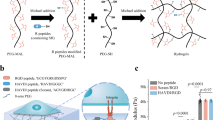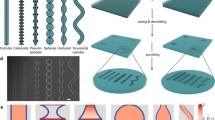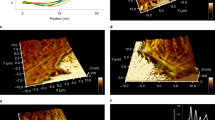Abstract
We report the establishment of a library of micromolded elastomeric micropost arrays to modulate substrate rigidity independently of effects on adhesive and other material surface properties. We demonstrated that micropost rigidity impacts cell morphology, focal adhesions, cytoskeletal contractility and stem cell differentiation. Furthermore, early changes in cytoskeletal contractility predicted later stem cell fate decisions in single cells.
This is a preview of subscription content, access via your institution
Access options
Subscribe to this journal
Receive 12 print issues and online access
$259.00 per year
only $21.58 per issue
Buy this article
- Purchase on Springer Link
- Instant access to full article PDF
Prices may be subject to local taxes which are calculated during checkout



Similar content being viewed by others
Change history
28 January 2011
In the version of this article initially published, the implication that it was the first work to decouple substrate rigidity from surface properties was incorrect, as we and others had previously reported the approach. Additional reference to previous work on micropost arrays also should have been included1. Our fabrication process, in which micropost arrays are doubly replica molded from microfabricated silicon masters, scales up production of these substrates and allows replication and distribution of disposable molds to potential users. 1. Saez, A., Buguin, A., Silberzan, P. & Ladoux, B. Biophys. J. 89, L52–L54 (2005).
References
Discher, D.E., Janmey, P. & Wang, Y.-L. Science 310, 1139–1143 (2005).
Vogel, V. & Sheetz, M. Nat. Rev. Mol. Cell Biol. 7, 265–275 (2006).
Ingber, D.E. Circ. Res. 91, 877–887 (2002).
Pelham, R.J. & Wang, Y.-L. Proc. Natl. Acad. Sci. USA 94, 13661–13665 (1997).
Paszek, M.J. et al. Cancer Cell 8, 241–254 (2005).
Engler, A.J., Sen, S., Sweeney, H.L. & Discher, D.E. Cell 126, 677–689 (2006).
Houseman, B.T. & Mrksich, M. Biomaterials 22, 943–955 (2001).
Keselowsky, B.G., Collard, D.M. & Garcia, A.J. Proc. Natl. Acad. Sci. USA 102, 5953–5957 (2005).
Tan, J.L. et al. Proc. Natl. Acad. Sci. USA 100, 1484–1489 (2003).
Yang, M.T., Sniadecki, N.J. & Chen, C.S. Adv. Mater. 19, 3119–3123 (2007).
McBeath, R., Pirone, D.M., Nelson, C.M., Bhadriraju, K. & Chen, C.C. Dev. Cell 6, 483–495 (2004).
Beningo, K.A., Dembo, M., Kaverina, I., Small, J.V. & Wang, Y.-L. J. Cell Biol. 153, 881–888 (2001).
Pittenger, M.F. et al. Science 284, 143–147 (1999).
Aubin, J.E. Biochem. Cell Biol. 76, 899–910 (1998).
Rosen, E.D. & Spiegelman, B.M. Annu. Rev. Cell Dev. Biol. 16, 145–171 (2000).
Madou, M. Fundamentals of Microfabrication 1st edn. (CRC Press, New York, USA, 1997).
Pirone, D.M. et al. J. Cell Biol. 174, 277–288 (2006).
Acknowledgements
We acknowledge financial support from the US National Institutes of Health (EB00262, HL73305 and GM74048), the Army Research Office Multidisciplinary University Research Initiative, the Material Research Science and Engineering Center, the Institute for Regenerative Medicine, the Nano/Bio Interface Center, the Center for Musculoskeletal Disorders of the University of Pennsylvania and the New Jersey Center for Biomaterials. J.F. and Y.-K.W. were both partially funded by the American Heart Association postdoctoral fellowship. M.T.Y. was partially funded by the National Science Foundation Integrative Graduate Education and Research Traineeship program (DGE-0221664). We thank P. Mao and Y. Veklich for assistance with electron microscopy, D.M. Cohen for critical feedback on the manuscript and members of the Microsystems Technology Laboratories at the Massachusetts Institute of Technology for support in cleanroom fabrication.
Author information
Authors and Affiliations
Contributions
J.F. and C.S.C. conceived and initiated project. J.F. and M.T.Y. designed and fabricated micropost arrays. J.F., Y.-K.W., M.T.Y., R.A.D., X.Y. and Z.L. designed and performed experiments, analyzed data and wrote the manuscript. C.S.C. supervised the project.
Corresponding author
Ethics declarations
Competing interests
The authors declare no competing financial interests.
Supplementary information
Supplementary Text and Figures
Supplementary Figures 1–6 and Supplementary Note 1 (PDF 939 kb)
Rights and permissions
About this article
Cite this article
Fu, J., Wang, YK., Yang, M. et al. Mechanical regulation of cell function with geometrically modulated elastomeric substrates. Nat Methods 7, 733–736 (2010). https://doi.org/10.1038/nmeth.1487
Received:
Accepted:
Published:
Issue Date:
DOI: https://doi.org/10.1038/nmeth.1487
This article is cited by
-
Osteopontin Rejuvenates Senescent Adipose-Derived Stem Cells and Restores their Bone Tissue Regenerative Function
Stem Cell Reviews and Reports (2024)
-
Nano-frictional mechano-reinforcing porous nanowires scaffolds
Friction (2024)
-
Tumor matrix stiffness provides fertile soil for cancer stem cells
Cancer Cell International (2023)
-
Biomechanical, biophysical and biochemical modulators of cytoskeletal remodelling and emergent stem cell lineage commitment
Communications Biology (2023)
-
Morphogenesis beyond in vivo
Nature Reviews Physics (2023)



